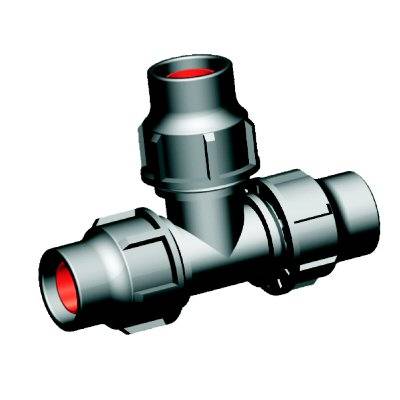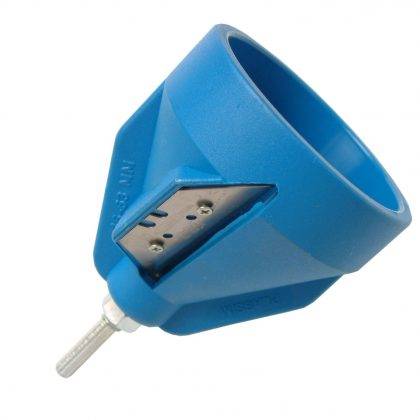Introducing Poly Pipe Fittings
Poly pipe fittings are integral components of modern irrigation systems, playing a crucial role in distributing water to areas within private gardens, commercial and public landscapes, and green roofs. These fittings are specifically designed to connect to and adapt poly pipes, and are known for their quality – including excellent durability, flexibility, and resistance to corrosion. In this blog, we’ll look at the types of poly pipe fittings used within an irrigation system, their benefits, and the correct ways to fit them.
These fittings are specifically designed to connect to and adapt poly pipes, and are known for their quality – including excellent durability, flexibility, and resistance to corrosion. In this blog, we’ll look at the types of poly pipe fittings used within an irrigation system, their benefits, and the correct ways to fit them.
The Importance of Poly Pipe Fittings
Poly pipe fittings are essential for creating efficient and reliable irrigation systems for several reasons. Firstly, they enable the connection of multiple separate single poly pipe runs – creating a seamless pipeline network that transports water to the different irrigation zones. These fittings enable changes in the direction of water flow, allowing for customized routing to reach specific areas, helping to ensure optimal coverage. Certain other poly pipe fittings, such as valves, provide control over the flow of water, allowing for precise management of irrigation zones and timing. There are a wide variety of poly pipe fittings available to accommodate different pipe sizes and types, ensuring compatibility and flexibility when designing irrigation systems. Poly pipe fittings also allow for quick, easy access to different areas of the irrigation system for vital maintenance and repairs, including draining the poly pipe runs down before the onset of winter. Poly pipe fittings also enable modifications to be made, such as the ability to expand the system at a later date – essentially future-proofing it and ensuring its long-term functionality.
Types of Poly Pipe Fittings and Their Benefits
The three most common types of poly pipe fittings are tees (which create a T-shaped intersection in the pipeline, allowing water to flow in three directions), (which provide a 90-degree change in direction within the pipeline – essential for navigating around obstacles or making turns in the irrigation system), and straight
connectors (which connect two sections of poly pipe together and are often used for extending the length of pipe runs). Also very commonly used are reducing fittings (to provide a smooth transition between poly pipes of different sizes), and end cap fittings (which terminate the end of a poly pipe run, and prevent water from escaping to ensure efficient and neat system operation). Electrically operated solenoid valve poly pipe fittings are also often used to incorporate a valve mechanism to automatically turn on and off the flow of water within the irrigation system according to the time and durations set on the irrigation controller. These sophisticated valves are commonly used to regulate water flow to specific zones within the irrigation system – a fantastic benefit which enables the irrigation system to be split into smaller, more manageable watering zones all operating at separate times – which is often essential for flow and pressure requirements.
Poly pipe fittings are highly resistant to corrosion, rust, and chemical degradation, ensuring a long service life. They are also highly versatile, meaning that they’re suitable for a wide range of irrigation applications, including popup sprinkler systems for watering lawns, and dripline systems for watering planted borders, hedges, trees, or green roofs.
The Installation of Poly Pipe Fittings within an Irrigation System
Correct installation of poly pipe fittings is essential for the efficient and reliable operation of irrigation systems and also helps to conserve water. One of the first things to consider before fitting is pipe preparation. You’ll need to ensure that the ends of the poly pipes are clean, smooth, and free from damage or debris before connecting the poly pipe fittings. An essential part of this is having a handy installation toolkit. There are three different tools (each one indispensable) which form the process of connecting poly pipe fittings. First up are the pipe cutters which are essential for providing a quick and clean cut to the poly pipe and to ensure that the pipe is cut squarely. These clean cuts guarantee a secure and leak-free connection. The use of pipe cutters is essential in preventing damage to the pipe which is easily caused by attempting to cut with unsuitable implements that are not designed for cutting poly pipe – such as garden secateurs or large scissors, which could lead to leaks or blockage. In contrast, using pipe cutters helps aid the integrity and reliability of the irrigation system. Next up we have the pipe chamfering tool – which is used to bevel the end of the pipe. Chamfering smooths the edges of the newly cut pipe – ensuring that the pipe slides smoothly into the poly pipe fitting. It also prevents damage to the compression rings or O-rings used in the fittings, helping to promote a watertight seal. Chamfering not only enhances the durability and effectiveness of the connection but also reduces the risk of leaks, by ensuring that the poly pipe fittings fit onto the pipe ‘like a glove’. Finally, once the fittings have been successfully connected, using a ‘C’ spanner is essential to ensure that they are fitted tightly, preventing them from working loose. The ‘C’ spanner is specifically designed to tighten the outer grip ring of poly pipe fittings in a quicker, easier, and more secure way than hand tightening will allow, therefore saving a substantial amount of time and effort. PTFE tape is also required on threaded poly pipe fittings which don’t have a seal. Three turns of PTFE tape around the male thread of the poly pipe fittings will ensure a watertight seal.

Summing up
We’ve seen how poly pipe fittings form an indispensable part of modern irrigation systems, by performing a range of different functions. This versatility makes them suitable for many different irrigation applications, ranging from use within sprinkler systems watering the lawn of a private garden to dripline systems watering the green roof of a shopping centre. Poly pipe fittings are crucial for developing the layout of irrigation systems by connecting all the separate parts together and enabling efficient and reliable operation of the system. Poly pipe fittings play an essential role in creating the irrigation systems which make beautiful gardens, public parks, and green roofs flourish, whilst also helping to conserve precious water resources.
